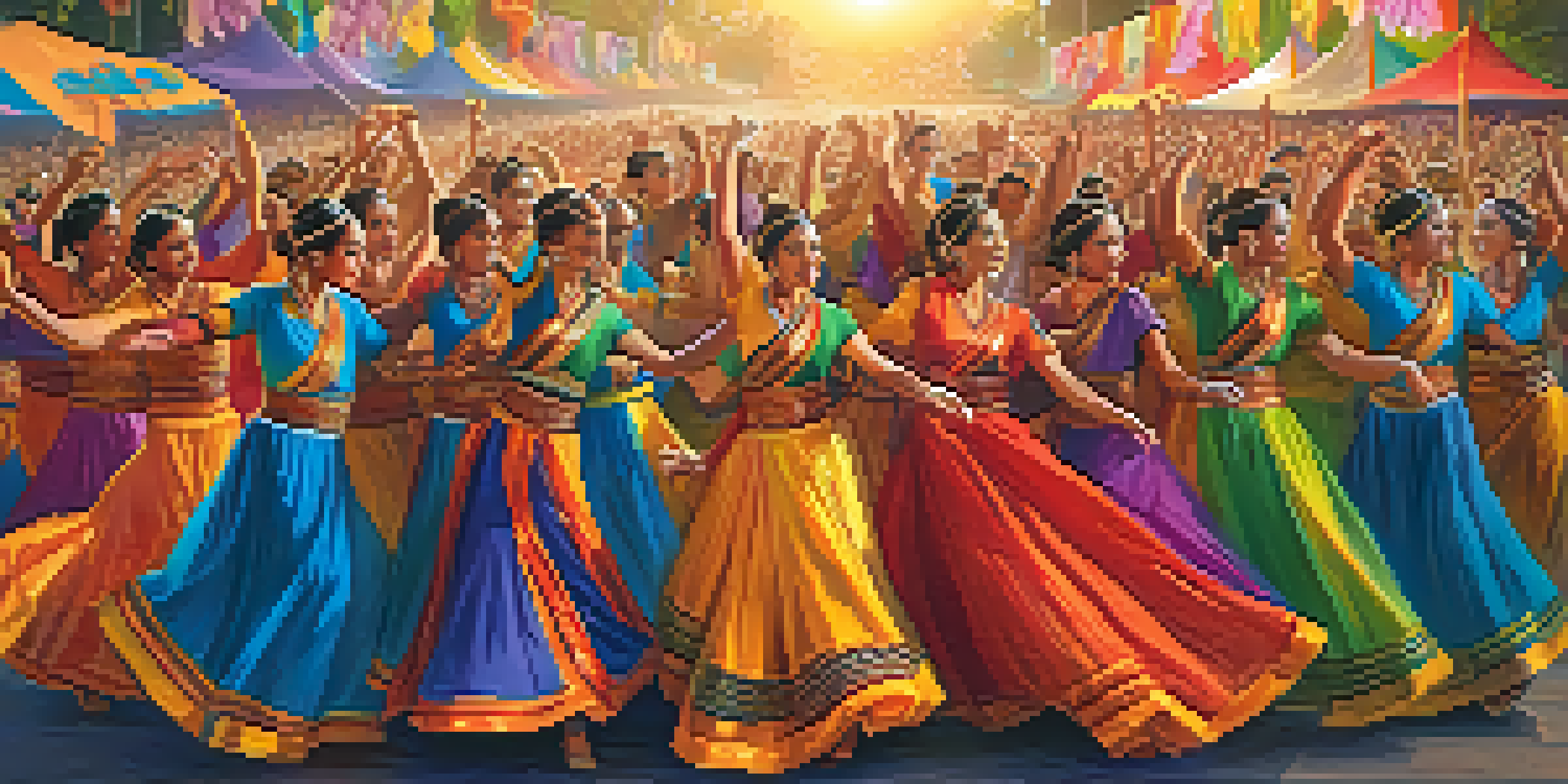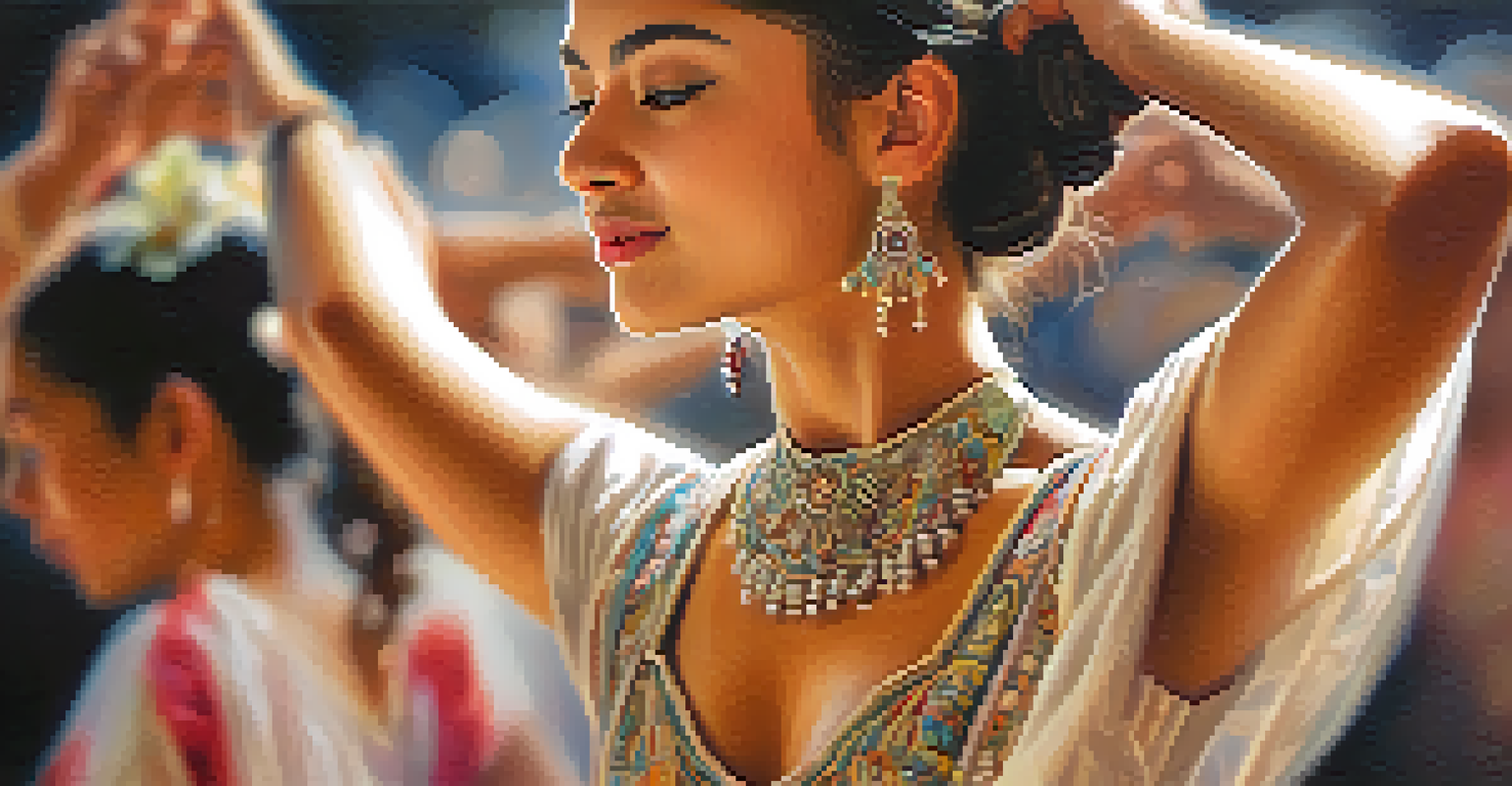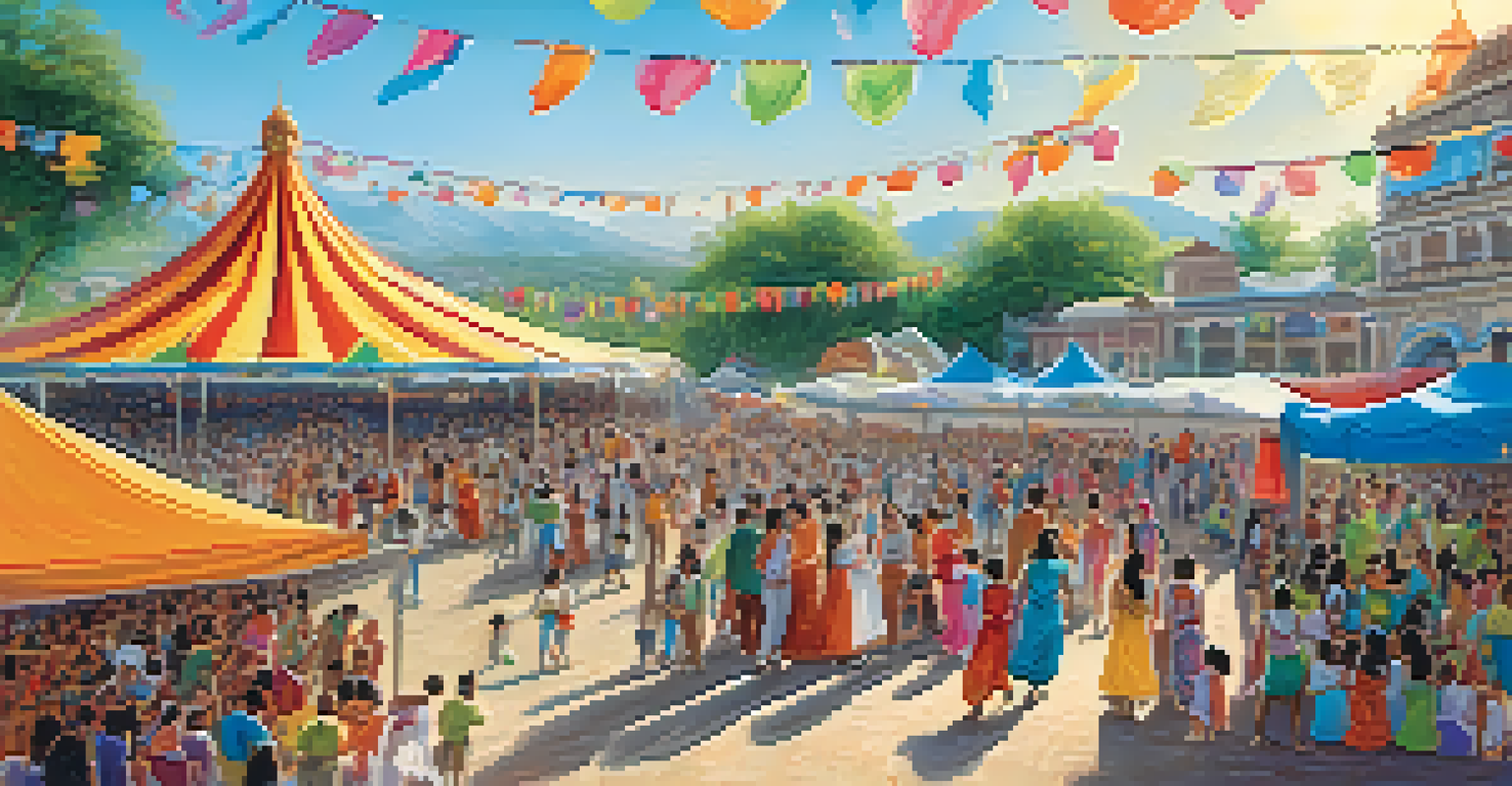Dance Festivals: A Global Platform for Cultural Exchange

The Essence of Dance Festivals in Cultural Exchange
Dance festivals are more than just celebrations; they serve as vibrant platforms for cultural exchange. At these events, communities come together to share their unique traditions through the universal language of dance. From traditional folk dances to contemporary styles, each performance tells a story that transcends linguistic barriers.
Dance is the hidden language of the soul.
For instance, the Edinburgh Festival Fringe showcases a diverse array of dance forms from around the world, inviting artists to share their heritage while learning from one another. This exchange not only enriches the performers but also offers audiences a chance to experience cultures they may never encounter otherwise. The beauty lies in the shared enjoyment and understanding that dance fosters.
Ultimately, dance festivals highlight the importance of cultural appreciation in our increasingly globalized world. They remind us that despite our differences, we can celebrate our shared humanity through movement and rhythm.
Celebrating Diversity: Dance Styles from Around the World
One of the most exciting aspects of dance festivals is the variety of styles on display. From the spirited Flamenco of Spain to the intricate Bharatanatyam from India, these festivals offer a glimpse into the rich tapestry of global dance. Each style embodies its culture's history, struggles, and triumphs, allowing audiences to connect with the performers on a deeper level.

Take, for example, the Rio Carnival, where Samba takes center stage. This electrifying dance not only entertains but also reflects Brazil's diverse cultural heritage, merging African, Indigenous, and European influences. Festivals like this invite participants to immerse themselves in the rhythm, fostering a sense of community and belonging.
Dance Festivals Foster Cultural Exchange
These events serve as vibrant platforms where communities share their unique traditions through the universal language of dance.
As dancers share their unique styles, they also encourage cross-cultural dialogue, inspiring new collaborations and fusion genres. In this way, dance festivals serve as a melting pot of creativity, where the blending of traditions can lead to innovative artistic expressions.
Building Bridges: Dance Festivals and Social Change
Dance festivals often go beyond entertainment; they can also serve as catalysts for social change. Many festivals focus on themes like inclusivity, empowerment, and environmental awareness, using dance as a tool to raise awareness and inspire action. For example, the Dance for Hope festival highlights issues such as mental health and community resilience.
The dance is a poem of which each movement is a word.
By bringing together dancers and activists, these festivals create a space for dialogue and reflection. They encourage participants to use their art as a voice for change, demonstrating the power of movement to address social issues. This fusion of art and activism can lead to transformative experiences for both performers and audiences alike.
Moreover, the impact extends beyond the festival itself, as participants carry these conversations back to their communities. Thus, dance festivals can not only entertain but also empower individuals, instilling a sense of responsibility and hope for a better future.
The Role of Technology in Modern Dance Festivals
In today's digital age, technology plays a significant role in enhancing the experience of dance festivals. Live streaming, social media, and virtual reality are transforming how audiences engage with performances. For instance, festivals like the American Dance Festival now offer online access, allowing viewers from around the globe to participate in real-time.
This technological shift not only broadens the audience reach but also encourages interaction among attendees, fostering a sense of global community. Social media platforms allow dancers to showcase their work, share insights, and connect with fans, creating a dynamic online presence that complements the live experience.
Dance Festivals Drive Social Change
By focusing on themes like inclusivity and empowerment, dance festivals use art as a catalyst for dialogue and social awareness.
As technology evolves, the possibilities for dance festivals are endless. Innovations like augmented reality can offer immersive experiences, allowing audiences to feel as if they are part of the performance. Embracing technology helps dance festivals remain relevant and accessible in a rapidly changing world.
Embracing Sustainability in Dance Festivals
Sustainability is becoming an essential theme in many contemporary dance festivals. Organizers are increasingly aware of their environmental impact and are implementing eco-friendly practices. From using sustainable materials for stages to promoting zero-waste initiatives, these festivals are leading the charge towards greener events.
A prime example is the Green Festival in California, which focuses on environmental awareness through the arts. By incorporating workshops and performances centered on sustainability, the festival encourages both artists and attendees to reflect on their ecological footprints. This initiative not only educates but also inspires action towards a more sustainable future.
By prioritizing sustainability, dance festivals can set a powerful precedent for other cultural events. They demonstrate that it is possible to celebrate art while being mindful of the planet, paving the way for a more responsible approach to cultural exchange.
The Economic Impact of Dance Festivals
Dance festivals can have a profound economic impact on local communities, drawing in tourists and boosting local businesses. These events often attract thousands of attendees, providing a substantial influx of revenue for hotels, restaurants, and shops. The economic benefits can be significant, particularly in smaller towns that host annual festivals.
For instance, the Montreal International Jazz Festival not only showcases exceptional talent but also generates millions in tourism revenue each year. Local vendors and artists benefit from increased exposure, creating a thriving marketplace that enhances the festival's atmosphere.
Economic Boost from Dance Festivals
Dance festivals significantly enhance local economies by attracting tourists and supporting local businesses, fostering a thriving cultural landscape.
Moreover, the success of these festivals can lead to increased support for the arts and culture within the community. As local governments recognize the economic advantages, they may become more inclined to invest in arts initiatives, fostering a richer cultural landscape for everyone.
Personal Stories: The Impact of Dance Festivals on Individuals
At the heart of every dance festival are the personal stories of individuals whose lives have been transformed by the experience. Many dancers cite festivals as pivotal moments in their careers, offering them opportunities to showcase their talents and connect with industry professionals. For aspiring artists, the chance to perform on a global stage can be a life-changing experience.
Take the story of a young dancer from a small village who travels to a major festival for the first time. The thrill of sharing her cultural heritage with a diverse audience not only boosts her confidence but also ignites a passion for dance that she carries with her long after the event. These personal connections to dance festivals highlight their importance in shaping identities and aspirations.

Beyond career opportunities, festivals can also foster lifelong friendships and collaborations. The bonds formed on the dance floor often transcend borders, leading to ongoing partnerships that enrich the artistic community. In this way, dance festivals create a ripple effect that extends far beyond the stage.